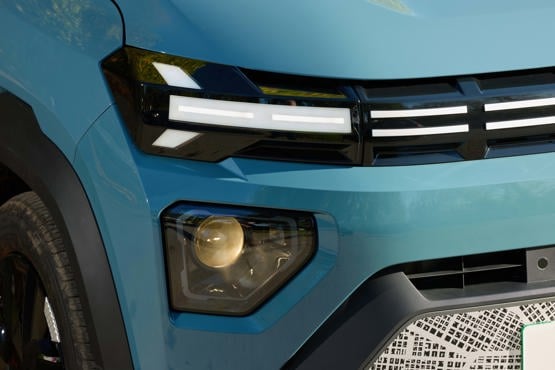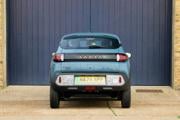Review
The Spring is the cheapest 'proper' electric car, comes well equipped and has a usable range, but it doesn't come without compromise.
Overview
Dacia built its brand on making the “UK’s cheapest car” and has since established itself with a no-nonsense line-up of robust and efficient models that resonate well with drivers.
As the brand has evolved, the focus has shifted to “best value” rather than lowest list price. For cars like the Sandero and Duster this has meant an uplift in quality and spec, without a major impact on overall running costs.
The Spring is a slightly different proposition. For all intents and purposes it is the UK’s cheapest electric car – if we disregard the Citroen Ami - and is billed as the gatekeeper to affordable electric vehicle (EV) ownership.
Prices start at £14,999, which is around £7,000 less than the next cheapest fully electric car, and actually makes it among the cheapest cars on sale full stop.
And when you consider the scale of Dacia’s parent company Renault Group and all the expertise, experience and components it has access to, the Spring should be a real game-changer.

Affordable electric cars have been in short supply, due to the engineering complexity of making a battery fit along with providing enough room for passengers and their luggage. By the time they reach market they are either too expensive, too compromised or simply don’t offer enough range.
Dacia, then, is the perfect candidate to take on the challenge and bring us the first cheap and cheerful small EV.
They’ve managed the ‘cheap’ part, but the ‘cheerful’? Not so much.
To understand the Spring in more detail, we first need to explore its origin. This isn’t a bespoke, ground-up new model that's built for Europe. That would have cost too much money. Instead, it’s a tweaked version of a Chinese-built Renault that went on sale in 2019 and was originally developed for India.
Dacia launched the car in some European markets, in 2021, but at the time it was deemed unworkable for the UK market.
After a facelift, bringing cosmetic changes, a boost to the interior and some engineering tweaks, the Spring arrived in the UK in late 2024.
Comfort and practicality
The Spring is a sub-compact model, so it sits beneath the conventional small car such as Renault’s Clio or the Vauxhall Corsa. Most manufacturers have moved away from this segment as drivers tend to prefer larger, more upmarket models.
As such, interior space on board the Spring is cramped. There’s limited width, squeezing occupants closer together, and not a great deal of rear legroom.
Up front the Spring feels more spacious. The dashboard design makes best use of the available space, giving a more airy feel. There are also large storage bins in the front doors and a useful space in front of the gear selector. Cupholders are extra, however.
Hard scratchy plastics and exposed metal panels are par for the course at this price point so we’ve not complaints there. The Spring has a likeable interior with contrasting white plastic bits to offset the more drab black parts.
Boot space is also impressive. There’s 308 litres of space, which is on par with larger models like the Vauxhall Corsa.
It seems less focus was put on comfort. The seats are hard and unsupportive, with limited adjustment. The steering wheel is made of a hard textured plastic. Long journeys can be a little fatigue inducing as a result.
Safety and technology
Euro NCAP awarded the Spring just one star in its safety test, with poor scores across the board including a 49% result for front occupant safety.
UK models are equipped with enhanced safety technology, including the legally mandated autonomous emergency braking, lane keep assist and speed sign recognition. This version is yet to be officially crash tested.
Dacia offers two trim grades: Expression and Extreme. The standard kit includes remote central locking, electric front windows and rear parking sensors. Expression models come with a basic audio system and Dacia Media Control. This uses a driver’s smartphone and a bespoke app in place of a conventional screen.
The Extreme gets a 10-inch touchscreen with sat-nav, Apple Carplay and Android Auto. It also comes with electric windows in the rear, electrically adjustable mirrors and a bi-directional charger that enables a device to be powered directly from the car's battery.
All versions are fitted with halogen headlights, complete with manual height adjustment, rather than the much brighter self-levelling LED units fitted to the majority of new cars.

Driveability and range
It’s fairly common for a lightweight, back-to-basics hatchback to be an absolute hoot to drive. They’re usually nimble, eager and intrinsically engaging. Combine that with the instant torque of an electric powertrain and you’ve got a recipe for success. The VW e-UP! is a good case in point.
Dacia didn’t get the memo. The Spring is not engaging, it’s not enjoyable and it’s frankly a little unsettling. It starts with wayward steering. Not particularly light and not particularly quick. It means you need to give a fair degree of input to get around corners.
Combine this with the car’s light weight and Dacia’s questionable decision to fit ‘Linglong’ budget tyres, and the Spring lacks assurance.
On damp roads it struggles to put down its power and when cornering the front end feels like it wants to push on and understeer. When it does find traction at the front, the rear tyres feel like they're going to give way causing the ESP to work overtime. Heavy braking is met with the eager interruption of the ABS.
Compared to modern superminis, the driving experience is really like stepping back in time.The car also has a raised ride height to give it more of a crossover look, but this means it leans into corners a fair bit. Over speed bumps the ride is quite harsh and bouncy. If Dacia used a little more of its engineering expertise to tune the chassis and fitted some better tyres, we feel the Spring would be a much better car.
Clearly designed for urban environments, rather than wet British B-roads, the Spring is more at home in 20-30mph limits. Here, it’s nimble and easy to manoeuvre around town and parking is a doddle.

We’ve only driven the more potent 65PS model, which has an official 0-62mph acceleration time of 12 seconds. It’s fairly nippy up to 40mph then the acceleration tails off. Also available is a 45PS version, which take almost 20 seconds to reach 62mph.
The WLTP range for either model is 140 miles, from a 28kWh battery. We saw an impressive 5.0mi/kWh at low speeds where the car could quite easily surpass its WLTP figure. On hillier roads, or motorways, you need to keep the throttle buried to maintain speed, which saps energy at a rate of around 3.5mi/kWh - giving a range closer to 100 miles.
At motorway speeds, wind and road noise is very intrusive, making for a tiring drive.
When it comes to charging, the battery can only take power at 30kW - meaning a 10%-80% top-up takes 45 minutes.
Company car tax and running costs
As the cheapest electric car on sale, the Spring also attracts the cheapest benefit-in-kind (BiK) tax and will cost drivers as little as £5 per month if they opt for the entry-level car.
Leasing deals are also very attractive, with one provider quoting £218 per month (4yr/50k). That's almost half the price they quoted for a Mini Hatch Electric.
The scarcely specced Expression may suit businesses that want a pool car or something for site use. User choosers are more likely to have the £17,000 Extreme model, with the more powerful motor.
When it comes to running costs, Cap HPI data shows the Spring is exceptionally cheap with a rate of 17ppm for the base model and 19ppm for the Extreme. This undercuts pretty much everything on the market.
However, the big caveat with the Spring is that it's not really 'cheap'. It compromises far to much compared to other small EVs when it comes to safety, performance and refinement, so the pricing is actually fair for what you're getting.
Matt has been an automotive journalist for nine years and has driven just about every new car and van that's on sale. As content editor - vehicles he is responsible for the automotive content on Fleet News and also contributes to Automotive Management. Prior to this, Matt worked in the automotive industry for 10 years.


Specs
| Manufacturer | Dacia |
| Model | Spring Hatchback |
| Specification | Dacia Spring Hatchback 27kWh Extreme 65 48kW 5dr Auto |
| Model Year | 2024.00 |
| Annual VED (Road tax) | £10 |
| BIK List Price | £16,930 |
| Range | 140.00mile(s) |
| CO2 | N/A |
| BIK Percentage | 3% |
| Insurance Group | N/A |
| CC | 1 |
| Fuel Type | Electric |
| Vehicle Type | Small car |
| Luggage capacity (Seats up) | 308litres |
| Doors | 5 |
Running Costs
| P11D | £16,930 |
| Cost per mile | 22.29ppm |
| Residual value | £6,025 |
| Insurance group | N/A |
| Fuel Type | Electric |
| Cost per mile | 80.02ppm |
| Fuel | 2.04ppm |
| Depreciation | 77.10ppm |
| Service maintenance and repair | 0.88ppm |
Rivals
Info at a glance
-
P11D Price
£16,930
-
MPG
N/A (WLTP) -
CO2 Emissions
N/A -
BIK %
3% -
Running cost
3 Year 60k : £6,025 4 Year 80k : £4,825 -
Fuel Type
Electric -
Range
140.00mile(s)



































Login to comment
Comments
No comments have been made yet.